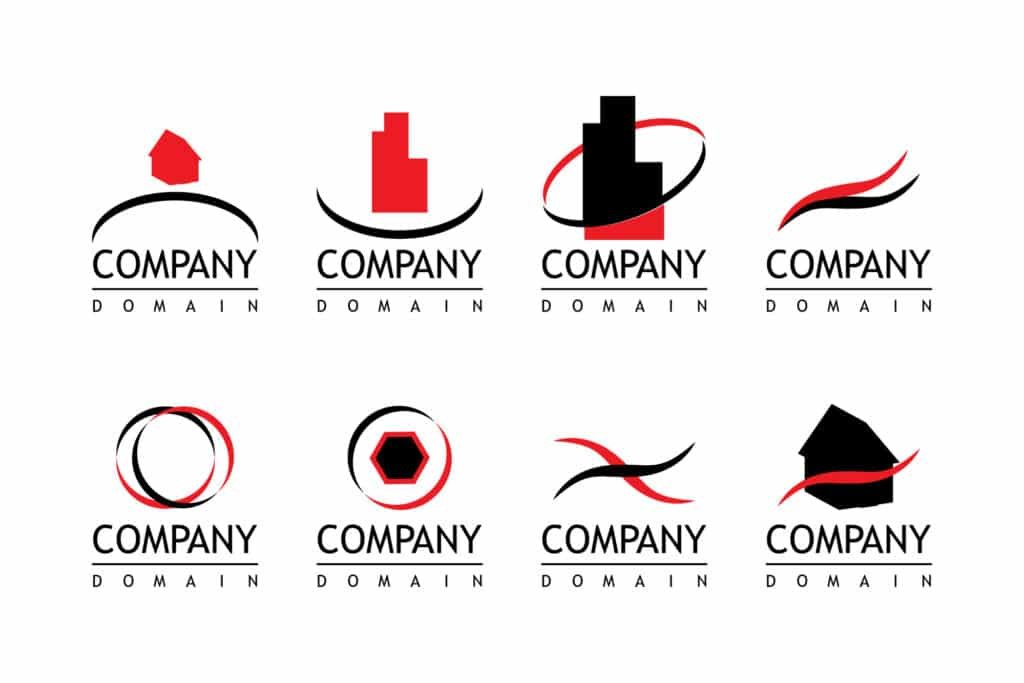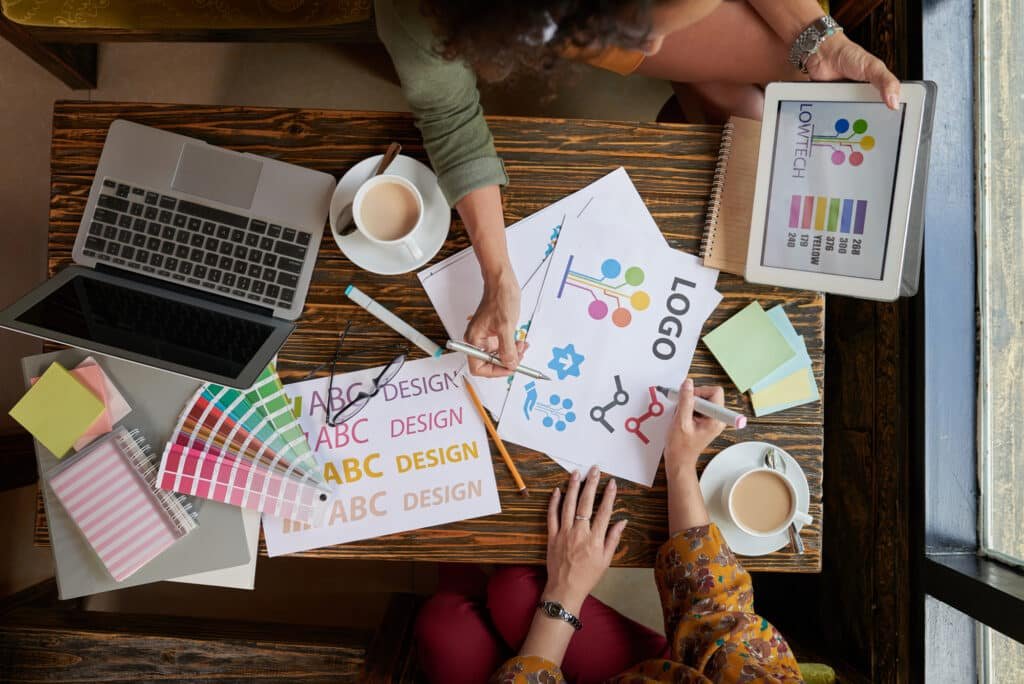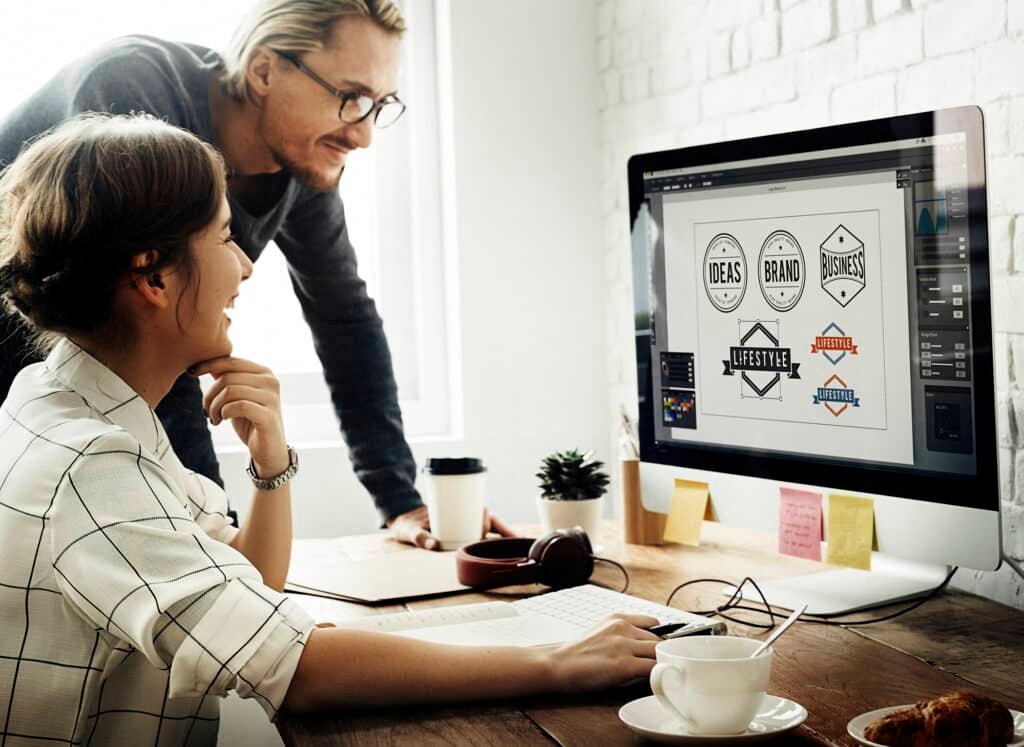A logo is a visual representation of your brand that can communicate your values, personality, and mission. It’s essential to have a well-designed logo to make your brand stand out and be memorable. However, not everyone has the budget to hire a professional designer to create a logo. The good news is that you can design a logo for free with a few simple steps.
Define your brand identity
Defining your brand identity is a crucial step in creating a logo that accurately reflects your brand. Your brand identity encompasses everything that your brand stands for, including its values, mission, personality, and unique selling proposition. Here are some key elements to consider when defining your brand identity:
- Brand values: Your brand values are the core principles that guide your business. They represent what your brand stands for, and what your customers can expect from you. Examples of brand values include honesty, innovation, sustainability, and customer satisfaction.
- Brand mission: Your brand mission is the reason why your brand exists. It’s the overarching purpose of your business, and it should guide all of your decisions. Your mission statement should be concise, memorable, and easily understood.
- Brand personality: Your brand personality is the human traits that your brand embodies. It’s how your brand comes across to your customers and how it differentiates you from your competitors. Your brand personality can be friendly, professional, playful, serious, or any other attribute that fits your brand identity.
- Target audience: Your target audience is the group of people who are most likely to be interested in your brand. Understanding your target audience is crucial to creating a logo that resonates with them. Consider their demographics, interests, and pain points when defining your brand identity.
- Unique selling proposition: Your unique selling proposition (USP) is what sets your brand apart from your competitors. It’s the thing that makes your brand unique, and it should be reflected in your logo design. Your USP might be your product features, customer service, or price point, among other things.
By defining your brand identity, you can create a logo that accurately reflects your brand’s values, mission, personality, target audience, and USP. This will help you create a strong brand identity that resonates with your customers and differentiates you from your competitors.
Research your competition

Researching your competition is an important step in creating a logo that stands out and sets your brand apart from others in your industry. Here are some key reasons why you should research your competition when designing your logo:
- Avoid creating a similar logo: By researching your competitors’ logos, you can ensure that your logo does not look too similar to theirs. A logo that looks too similar to a competitor’s logo can confuse customers and make it harder for them to differentiate between the two brands.
- Identify industry trends: By researching your competitors’ logos, you can identify any trends in your industry. This can help you understand what types of logos are popular and what types of logos are outdated. This information can guide your logo design and help you create a logo that is both timeless and relevant.
- Understand your competitors’ brand identities: By researching your competitors’ logos, you can understand their brand identities. This includes their brand values, personality, and unique selling proposition. Understanding your competitors’ brand identities can help you differentiate your brand and create a logo that accurately reflects your own brand identity.
- Identify gaps in the market: By researching your competitors’ logos, you can identify any gaps in the market that your brand can fill. This can help you create a logo that addresses these gaps and sets your brand apart from others in your industry.
When researching your competition, it’s important to look beyond just their logos. Look at their website, social media channels, and advertising to get a better understanding of their brand identity. Consider what you like and don’t like about their branding, and use this information to guide your logo design.
Choose your logo type

Choosing the right logo type is an important step in creating a logo that accurately represents your brand. There are several types of logos to choose from, and each has its own advantages and disadvantages. Here are some of the most common types of logos:
- Wordmark logos: Wordmark logos, also known as logotypes, use only the name of the brand in a stylized font. This type of logo is best for brands with a unique name that is easily recognizable.
- Lettermark logos: Lettermark logos, also known as monogram logos, use the initials of the brand in a stylized font. This type of logo is best for brands with a long name or a difficult-to-pronounce name.
- Pictorial logos: Pictorial logos, also known as brand marks, use a graphic or icon to represent the brand. This type of logo is best for brands with a recognizable visual identity, such as Apple or Nike.
- Abstract logos: Abstract logos use geometric shapes or other abstract elements to represent the brand. This type of logo is best for brands with a modern or cutting-edge image.
- Mascot logos: Mascot logos use a cartoon or other character to represent the brand. This type of logo is best for brands that want to communicate a friendly or playful image, such as sports teams or children’s products.
- Combination logos: Combination logos use a combination of text and graphics to represent the brand. This type of logo is best for brands that want to communicate a complex message or a combination of brand attributes.
When choosing your logo type, consider what best represents your brand identity, values, and personality. Think about your target audience and what type of logo will resonate with them. Also, consider the practicality of your logo type. For example, a complex pictorial logo might not work well in small sizes or in black and white.
Sketch your ideas

Sketching your ideas is an important step in the logo design process. This is the stage where you can explore your creative ideas and generate a range of possible designs. Here are some tips to help you sketch your ideas effectively:
- Use a pencil and paper: Start with pencil and paper to sketch out your ideas. This allows you to work quickly and easily make changes as you go along. Don’t worry about creating a perfect design at this stage; focus on generating as many ideas as possible.
- Explore different concepts: Don’t limit yourself to one idea or concept. Explore different directions and ideas to find the one that works best for your brand. Try sketching different shapes, symbols, and letterforms that relate to your brand identity.
- Get inspiration: Look for inspiration from other logos, your industry, or your brand identity. This can help you generate ideas and get a sense of what works and what doesn’t. However, be careful not to copy other logos or infringe on copyright.
- Refine your ideas: Once you have a few sketches that you like, it’s time to refine them. Focus on simplifying the design, making it more memorable, and ensuring it communicates your brand values. This is the stage where you can refine the colors, fonts, and layout of your logo.
- Get feedback: Share your sketches with others and get feedback on your ideas. This feedback can help you understand what people like and don’t like about your designs. It can also help you identify any areas that need improvement or refinement.
- Choose your top sketches: Based on your feedback, choose your top sketches and refine them further. This is the stage where you can start to experiment with color, typography, and layout. Remember to keep your brand identity, values, and personality in mind when making these decisions.
Sketching your ideas is an important step in creating a logo that accurately represents your brand. By exploring different concepts, getting inspiration, refining your ideas, getting feedback, and choosing your top sketches, you can create a logo that resonates with your target audience and accurately communicates your brand values, personality, and unique selling proposition.
Refine your design

Refining your logo design is an important step in creating a memorable and effective logo that accurately represents your brand identity. Here are some tips to help you refine your design:
- Simplify the design: One of the most important things to focus on when refining your logo design is to simplify it. Your logo should be easy to recognize and memorable, and complex designs can make it harder for customers to remember and understand.
- Focus on the details: Once you have simplified your design, it’s time to focus on the details. Refine the colors, fonts, and layout of your logo to ensure that it accurately represents your brand identity and values. Consider how your logo will look on different materials and in different sizes.
- Get feedback: Feedback from others is essential in refining your logo design. Share your design with friends, family, or colleagues and ask for their opinions. Consider their feedback, and use it to guide your design decisions.
- Iterate: Refining your logo design is an iterative process. Don’t be afraid to experiment with different ideas and variations until you find the design that works best for your brand. Keep refining your design until you are satisfied that it accurately represents your brand identity and values.
- Consider the context: When refining your logo design, it’s important to consider the context in which it will be used. Think about where your logo will appear, such as on a website, business card, or signage. Ensure that your design is scalable and legible in different sizes and formats.
- Stand out: Finally, ensure that your logo design stands out from your competitors. Look at other logos in your industry and identify any similarities or trends. Use this information to create a design that is unique and memorable, and that accurately represents your brand identity and values.
Refining your logo design is an essential step in creating a logo that accurately represents your brand identity and values. By simplifying your design, focusing on the details, getting feedback, iterating, considering the context, and standing out, you can create a memorable and effective logo that resonates with your target audience and accurately communicates your brand values and unique selling proposition.
Get feedback

Getting feedback on your logo design is an essential step in creating a logo that accurately represents your brand and resonates with your target audience. Here are some tips to help you get effective feedback on your logo design:
- Share your design with others: Share your logo design with a variety of people, including friends, family, colleagues, and your target audience. Consider sharing your logo on social media, forums, or design communities to get a wider range of feedback.
- Ask specific questions: When seeking feedback on your logo design, it’s important to ask specific questions. For example, you might ask if the logo accurately represents your brand identity, if it’s memorable, if it stands out from competitors, or if it’s easily recognizable.
- Consider feedback objectively: When receiving feedback, it’s important to consider it objectively. Try not to take criticism personally and instead use it as an opportunity to improve your design. Remember that feedback is subjective, and not everyone will have the same opinion.
- Consider the source of feedback: Consider the source of feedback when evaluating its usefulness. Feedback from your target audience is more valuable than feedback from someone who is not part of your target audience. Consider the expertise of the person giving feedback, and use their suggestions to guide your design decisions.
- Don’t rely solely on feedback: While feedback is valuable, it’s important not to rely solely on it when making design decisions. Ultimately, you know your brand best and should make design decisions that accurately represent your brand identity and values.
- Iterate based on feedback: Use the feedback you receive to iterate and refine your logo design. Consider the suggestions that resonate with you, and incorporate them into your design. Refine your design until you are satisfied that it accurately represents your brand identity and values.
Getting feedback on your logo design is an important step in creating a logo that accurately represents your brand identity and resonates with your target audience. By sharing your design with others, asking specific questions, considering feedback objectively, considering the source of feedback, not relying solely on feedback, and iterating based on feedback, you can create a memorable and effective logo that accurately communicates your brand values and unique selling proposition.
Finalize your design
Finalizing your logo design is the last step in the logo design process. It’s the stage where you make any final adjustments and approve your design for use. Here are some tips to help you finalize your design:
- Take a break: Before finalizing your design, take a break from it for a few days. This can help you come back to your design with fresh eyes and a new perspective.
- Review your design: Once you are ready to finalize your design, review it carefully. Ensure that it accurately represents your brand identity and values, is memorable and easily recognizable, and stands out from competitors. Check for any errors or inconsistencies, and ensure that it works well in different sizes and formats.
- Get feedback: Consider getting feedback from others one last time before finalizing your design. Share your design with a variety of people, including your target audience, and ask for their honest opinions.
- Make any final adjustments: Based on your review and feedback, make any final adjustments to your design. This might include tweaking the colors, adjusting the layout, or refining the typography.
- Choose your final file formats: Once you are satisfied with your design, choose your final file formats. This might include vector files for scalability, high-resolution files for printing, and low-resolution files for web use.
- Save and archive your files: Save and archive your files in a safe place, such as in the cloud or on an external hard drive. Ensure that you have a backup of your files in case you need to make any changes in the future.
Finalizing your logo design is an important step in creating a memorable and effective logo that accurately represents your brand identity and values. By taking a break, reviewing your design, getting feedback, making any final adjustments, choosing your final file formats, and saving and archiving your files, you can create a logo that resonates with your target audience and accurately communicates your brand values and unique selling proposition.
Get professional help

Getting professional help with your logo design can be a great option if you don’t have the skills, time, or resources to design it yourself. Here are some reasons why you might want to consider getting professional help:
- Expertise: Professional designers have expertise in logo design, and can create a logo that accurately represents your brand identity and values. They have experience with design principles, color theory, typography, and layout, and can create a logo that resonates with your target audience.
- Time-saving: Designing a logo can be a time-consuming process, and it can take away from other important aspects of your business. Hiring a professional designer can save you time and allow you to focus on other important tasks.
- Professionalism: A professionally designed logo can give your brand a sense of professionalism and credibility. It can also help to set you apart from your competitors and establish your brand as a leader in your industry.
- Customization: Professional designers can create a logo that is customized to your brand identity and values. They can work with you to understand your brand, target audience, and unique selling proposition, and create a logo that accurately represents these factors.
- Versatility: Professional designers can create a logo that works well in different formats and sizes. They can create a logo that is scalable and works well on different materials, such as business cards, signage, and websites.
When choosing a professional designer, it’s important to research their portfolio, reviews, and pricing. Look for a designer who has experience with logo design and has worked with clients in your industry. Consider your budget and ensure that the designer’s pricing fits within your budget.
Getting professional help with your logo design can be a great option if you don’t have the skills, time, or resources to design it yourself. Professional designers can provide expertise, save you time, give your brand a sense of professionalism, customize your design, and create a logo that works well in different formats and sizes.
Conclusion
Designing a logo for free can be a cost-effective way to create a memorable and effective logo that accurately represents your brand identity and values. By starting with your story, brainstorming words that describe your brand, sketching ideas, testing your top sketches with your buyer persona, refining your chosen sketch, developing your logo’s layout on a free design platform, picking versatile color options, choosing a font, and ensuring scalability, you can create a logo that resonates with your target audience and accurately communicates your brand values and unique selling proposition.
While designing a logo for free can be a great option for those on a budget, it’s important to remember that it requires time, effort, and creativity to create a memorable and effective logo. If you don’t have the skills, time, or resources to design a logo yourself, you might want to consider getting professional help.
Designing a logo for free can be a rewarding and cost-effective way to create a logo that accurately represents your brand identity and values. By following the steps outlined in this article, you can create a logo that resonates with your target audience and accurately communicates your brand values and unique selling proposition. Whether you choose to design your logo yourself or get professional help, a memorable and effective logo is essential in establishing your brand identity and standing out from your competitors.
FAQs
Yes, you can design a professional-looking logo for free using various online design tools and resources available. However, designing a logo requires time, effort, and creativity, so it’s important to invest these resources to create a memorable and effective logo.
When choosing colors and fonts for your logo, consider your brand identity and values, your target audience, and ensure scalability. Choose a color palette that accurately represents your brand and its unique selling proposition and is consistent across all your branding materials. Choose typography that is legible and works well with your brand identity.
Researching your competition is important in creating a logo that stands out from your competitors and accurately represents your brand identity and values. This research can help you identify trends, similarities, and unique selling propositions in your industry, which you can use to create a logo that resonates with your target audience and sets you apart from your competitors.
Getting professional help to design your logo can be a great option if you don’t have the skills, time, or resources to design it yourself. Professional designers have expertise, can save you time, provide a sense of professionalism, customize your design, and create a logo that works well in different formats and sizes. However, designing a logo for free is also possible, but it requires time, effort, and creativity.